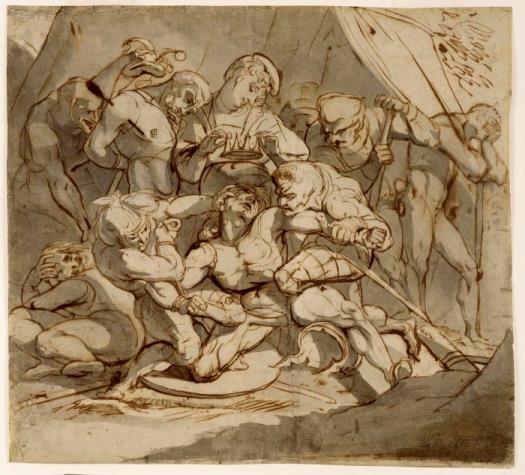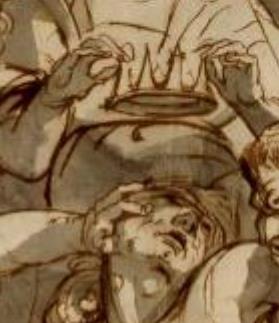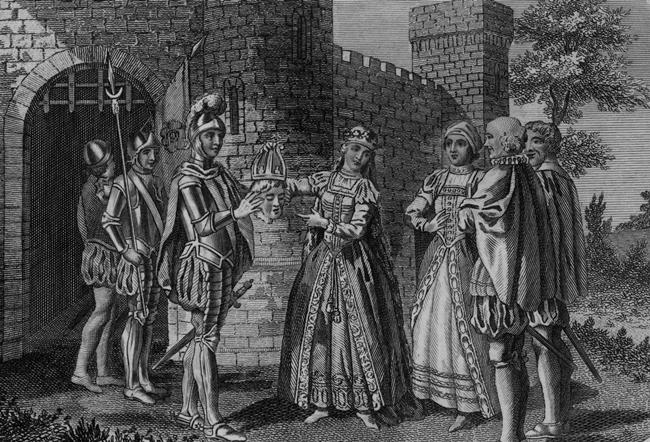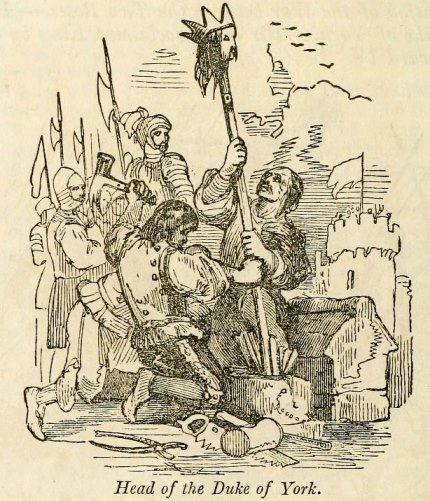| The Public Paperfolding History Project
Last updated 24/9/2024 x |
|||||||
| Richard of York and the Paper Crown | |||||||
| This page gives the
historical evidence for the story that Richard of York
(aka Richard Plantagenet) was mocked by having a paper
crown placed on his head either before, or shortly after.
his death during, or shortly after, the Battle of
Wakefield in 1460. There is insufficient early evidence to corroborate that the incident is historical but it is clear that paper crowns must have existed in 1548 for Edward Hall to have included one in his narrative. Shakespeare also clearly saw nothing strange in the idea of including mention of a paper crown in his play. But what did these paper crowns look like? We clearly cannot know since there are no contemporary illustrations. Such illustrations as we have are much, much later, and therefore probably anachronistic. It is also possible that if a paper hat was indeed placed on Richard of York's head it was in fact a Mitre of Infamy rather than a crown. Much of the information on this page is taken from the article 'The Battle of Wakefield' by Keith Dockray and Richard Knowles. ********** c1465 As far as I know the idea that Richard of York was mocked by having a crown made of humble materials, in this case reeds rather than paper, placed on his head first occurs in Whethamstede's Register (aka Registrum Abbatiae Johannis Whethamstede) which is said to have been compiled soon after Abbott Whethamstede's death in 1465. Dockray and Knowles translate the relevant passage as: 'They stood him on a little anthill and placed on his head, as if a crown, a vile garland made of reeds, just as the Jews did to the Lord, and bent the knee to him, saying in jest, 'Hail King, without rule. Hail King, without ancestry, Hail leader and prince, with almost no subjects or possessions'. And having said this and various other shameful and dishonourable things to him, at last they cut off his head.' ********** 1548 'The Union of the Two Noble and Illustre Families of Lancastre and Yorke' by Edward Hall, commonly known as Hall's Chronicle, was first published in 1548, appears to be the first source to state that the crown was made of paper. It contains the following passage (again from Dockray and Knowles): ... this cruel Clifford, not content with this homicide, came to the place where the dead corpse of the Duke of York lay, and caused his head to be stricken off, and set on it a crown of paper, and so fixed it on a pole, and presented it to the Queen, not being far from the field, saying 'Madame, your war is done, here is your Queen's ransom', at which present was much joy and great rejoicing. [The Queen] caused the Earl of Salisbury, with all the other prisoners, to be sent to Pomfret, and there to be beheaded, and sent all their heads, and the Duke of York's head, to be set upon poles over the gates of the city of York.' ********** 1591 William Shakespeare's play 'King Henry VI part III', written in this year, contains the stage direction 'Putting a paper crown on his head' and the following lines, spoken by Queen Margaret: York cannot speak, unless he wear a crown. A crown for York! and, lords, bow low to him: Hold you his hands, whilst I do set it on. (Putting a paper crown on his head) Ay, marry, sir, now looks he like a king! Ay, this is he that took King Henry's chair, And this is he was his adopted heir But how is it that great Plantagenet Is crown'd so soon, and broke his solemn oath? As I bethink me, you should not be king Till our King Henry had shook hands with death. And will you pale your head in Henry's glory, And rob his temples of the diadem, Now in his life, against your holy oath? O, 'tis a fault too too unpardonable! Off with the crown, and with the crown his head; And, whilst we breathe, take time to do him dead. ********** 1771 This illustration is by Henry Fuselli, a Swiss-born artist who worked mostly in London.
********** 1804 This illustration, by an unknown artist, which is said to date from 1805, shows the same scene, but the paper crown is so ornate as to nullify any mockery that may have been intended.
********** 1854 This illustration from Samuel Goodrich's 'A Pictorial History of England', published in 1854.
********** |
|||||||



